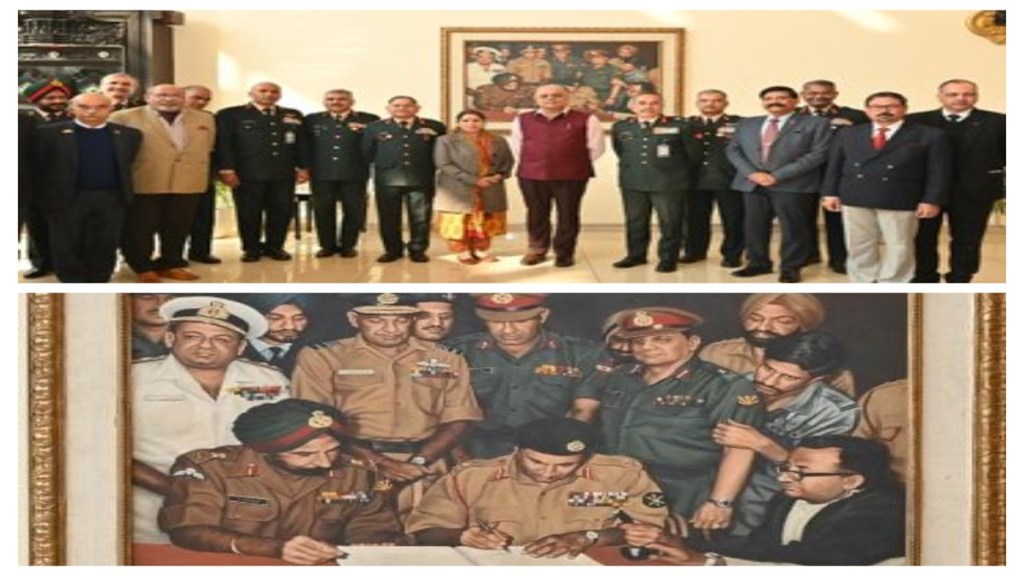On December 16, 2024, as the nation observed Vijay Diwas, a significant event unfolded that connected India’s military history with its present. General Upendra Dwivedi, Chief of the Army Staff (COAS), alongside his wife, Mrs. Sunita Dwivedi, inaugurated the installation of the iconic 1971 surrender painting at a new, prominent location: the Manekshaw Centre in Delhi Cantonment. This momentous gesture not only commemorated one of India’s greatest military victories but also honoured the legacy of Field Marshal Sam Manekshaw, the architect of India’s triumph in the 1971 India-Pakistan war.
The relocation of the painting, which portrays the surrender of the Pakistani Army in Dhaka, Bangladesh, has sparked a significant discussion, especially after the painting was recently moved from its earlier location at the office of the Indian Army Chief in South Block. The painting had been a long-standing symbol in the Army headquarters, representing the monumental victory that marked India’s emergence as a dominant military power. However, its removal from that space, followed by the placement of a new painting depicting modern-day military technology at the Line of Actual Control (LAC), had led to public outcry, particularly among military veterans.
The 1971 surrender painting, which depicts the moment when General Amir Abdullah Khan Niazi of Pakistan signed the instrument of surrender, marking the creation of Bangladesh, is a powerful reminder of the victory that united India. This victory was not just a military achievement, but also a statement of India’s commitment to justice and humanity.
As the painting now takes its place at the Manekshaw Centre, it finds itself in an ideal location where it will be seen by a wide array of visitors, both domestic and international. The Manekshaw Centre, named after Field Marshal Sam Manekshaw, is not only a fitting tribute to the 1971 war but also serves as a venue for important events attended by dignitaries and military personnel. The Centre’s significant foot traffic ensures that the surrender painting will continue to inspire and educate a broad audience about this defining moment in Indian military history.
General Dwivedi’s decision to reinstall the painting on Vijay Diwas reflects a deep respect for the nation’s military heritage. Speaking on the significance of the painting’s new home, the Indian Army shared on X (formerly Twitter): “This painting is a testament to one of the greatest military victories of Indian Armed Forces and the commitment of India for justice and humanity for all.” By placing the painting in a location that attracts both military personnel and visitors from around the world, the Army aims to honour the past while promoting the values of justice, courage, and sacrifice that are integral to the country’s identity.
The relocation of the painting comes in the wake of a controversy that sparked heated debate on social media. Last week, a photo of the Army Chief meeting his counterparts from Nepal, the Navy, and the Air Force surfaced online, showing the new painting in the background. This new artwork, depicting tanks near Pangong Tso on the Line of Actual Control and incorporating symbols of India’s modern military strength, replaced the iconic 1971 surrender painting.
The decision to replace the surrender painting raised concerns among military veterans, particularly those like Lt General HS Panag (Retd.), who expressed dissatisfaction on social media. Panag voiced his opinion on X, stating, “The painting symbolizing India’s first major military victory in 1,000 years has been removed by a hierarchy that believes that mythology, religion, and fragmented feudal history will inspire future victories.”
Despite the backlash, the Indian Army defended the change, emphasizing that the Army Chief’s office regularly updates its artwork to reflect both historical and contemporary themes. The current painting, which blends civilizational history with modern military technology, is seen as a reflection of India’s evolving defence posture, particularly in the face of new geopolitical challenges along the LAC.
Ultimately, the repositioning of the 1971 surrender painting at the Manekshaw Centre serves as a fitting tribute to India’s military achievements, ensuring that the legacy of the 1971 war, and the heroism of those who fought in it, continues to be honoured. As the country commemorates Vijay Diwas, this installation serves not only as a remembrance of past triumphs but as an enduring symbol of the strength and unity of India’s armed forces.

